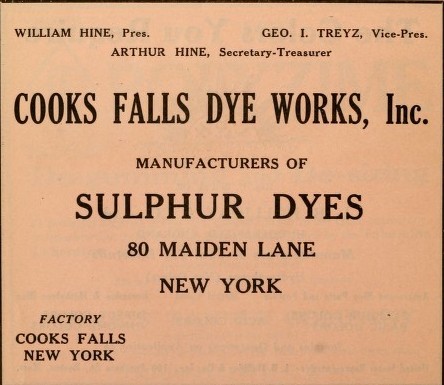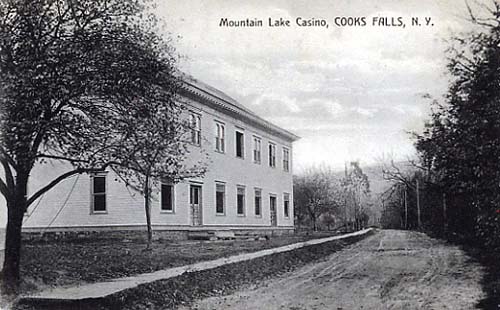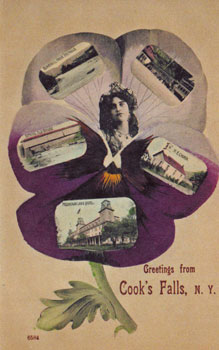|
Cooks Falls Cooks Falls was originally called Butternut Grove by the Cook brothers John and Robert who first built their log cabin on the banks of the Beaverkill River about seven miles west of the merger of the Beaverkill and Willowemoc Rivers. The Francisco and Pelton families also built their cabins along the Beaverkill. They were among the families who ran thousands of feet of timber to the lower Delaware River markets during the century of rafting on the Beaverkill River. The falls on the Beaverkill made it impossible to float the large rafts of timber through that part of the river and this prompted the blasting of the falls to eliminate the drop and grading of the channel to facilitate the log rafts through Cooks Falls. Because of the size of the Beaverkill at Cooks Falls a larger percentage of log rafts began their journeys to the mills and markets in Philadelphia from this point. Half rafts were formed and then two of them would lashed together at East Branch to make the large Delaware River rafts. The rafting business flourished between 1875 and 1885. It is reported that in 1875 over three thousand rafts floated down the Delaware River after an usually long spring freshet. Rafting began to decline through the last part of the century and with the arrival of the railroads most mills closed and rafting came to an end. Rafting Families
John Francisco Sr. was one of the first settlers of Butternut Grove and began rafting around 1830 and continued until 1840. His son John Jr. continued his father's work and rafted until 1855 and was followed into the business by his sons Lorenzo and Rudolphus and his great-grandson Virgil and his adopted son Nicholas J. Miller, all who rafted until about 1891. Joseph Cook was also one of the first rivermen; along with his son Halsey, and grandson Parker. Joseph's brothers Jonas and Enoch came to Cooks Falls later and entered the flourishing lumber business. Enoch's sons Henry, Horton and Jeptha became raftsmen, as well as Jeptha's sons, Willis, Marvin, William D. and Washa. Another son of one of three original settlers of Cooks Falls, was Milton Pelton. He and his son Harvey also rafted on the Beaverkill. Virgil Francisco kept a record of the raftsmen from Cooks Falls and listed William Stuart and his sons, Leslie, Lester and Irving; Abram Sprague along with his sons John and Cornelius and grandson Clark; William and Milo Steenrod, Ira Howard, Arthur Grant, Harrison Terbush, Jamesom L. Roosa, Isaac, Ed and George Tyler; Eugene Lakin, Pratt, Hope and Dan Chamberlain, Fred Walker and his sons Frank and George; Samuel Cable, Matthew Russell, Sylvester and Edwin Jagger. Francisco also noted these skilled steersmen: John Gregory, Bradley Allison and Frank P. Walker. Acid Factories
Bayard T. Tuttle and W.W. Gregory were the original owners of the Beaver Kill Dye Works company. Tuttle had been one of the organizers and the majority stockholder was Ralph Roosa of Cooks Falls. Roosa had claimed the discovery of a breakthrough process to make dyes. In 1918, it appears that Tuttle and Gregory were bought out. The Cooks Falls Dye Works, Inc. was established in May 1918 and stock certificates show the principal owners were George I. Treyz and William, Harry, Arthur and Herbert Hines. Another successful collaboration was made with a Treyz's friend and a Cook's Falls summer boarder, a German chemist, Dr. Hans Brunning, who operated the clothing dye plant on Russell Brook. The O&W railway brought in equipment and supplies and in turn transported the finished products to New York City and other clothing manufactures throughout the country. When the supply of German dyes was cut off during World War I, the Cooks Fall's Dye Works supplied most of the khaki/olive drab dye for U.S. military uniforms. The Cooperstown Otsego Farmer reported on April 8, 1921 from a Downsville News article about one of the unusual techniques used at the Dye Works, "Who would think that an ice crop could be gathered now when the ice is out of the rivers and robins and blue birds are in evidence everywhere in this section. The new superintendent of the Cooks Falls Dye Works made the announcement Monday that in order to make a new kind of dye, a thousand pounds of ice would be needed daily. G. I. Treyz immediately set his men in motion and they are cutting twelve inch ice on Russell Pond, which is being hustled to the dye works on Russell Brook, two miles from Cooks Falls." The plant continued to be innovative and successful and operated until approximately 1949.
Tourism The O & W railroad promoted the Catskills to New York City residents, issuing their annual tourist guide "Summer Homes," which advertised the accommodations along their lines. These guides sold the Catskill's healthy air, scenic views, trout rich streams and inexpensive vacations just a few hours from the city. By the late 1800's the Catskill Mountain region gave birth to the American fly fishing tradition. The West and East Branches of the Delaware and the Beaverkill, attracted many great anglers. Private fishing clubs sprang up in around the Beaverkill and Willowemoc. Writers such as John Burroughs, Theodore Gordon and Art Flick wrote about the beauty of the area and of their fishing adventures in the Catskills. Boarding houses and small hotels began opening to accommodate the urban travelers that sought to escape the summer heat and congestion of the cities, take in the scenic views and share the romantic feel of the pristine wilderness. Cooks Falls attracted tourist starting in the late 1800's. In May of 1904 The Downsville News reported that the Cooks Falls post office was enlarged in anticipation of the great amount of summer boarding business for the coming season. In June of 1906 The Downsville News reported that, "V.A. Francisco, proprietor of the Mountain Lake Hotel at Cook's Fall, was in Walton getting his big house ready for summer guests. When it is all completed it will accommodate over 300. He will have it ready this year for 275. His dining room will seat 360. Forty-two rooms are furnished with private baths. Mr. Francisco went into the summer hotel business in 1893 and has steadily increased his business ever since. Last year he had 150 summer guests and turned away as many more." The hotel was later sold to G.I. Treyz. The Downsville News reported that Treyz sold the hotel to a "New York party on contract for a price said to be $20,000 in 1919. The hotel operated under the names of Mountain Lake Hotel, Cooks Falls Lodge and the Cooks Falls Casino. The hotel employed many local residents and also is remembered for their dining room and wonderful dances that were hosted at the hotel. The old hotel was purchased by Nicnor Martinez and Miguel Rodriguez of North Bergen, New Jersey and was going through renovations when a fire destroyed the structure in 1977.
Other small hotels sprung up to take the overflow from the Mountain Lake Hotel. Local farmers also opened their homes during the summer months to offer a more intimate look into rural life and also to supplement their farm incomes.
Cooks Falls Church
The Cooks Falls church was built on the lands deeded on December 9, 1881 by Amasa Parker Cook and Martha Jane Francisco. The church was incorporated on July 15, 1889 as the Methodist Church of Butternut Grove. The church had a full time minister until 1939 when the Rockland Methodist and Roscoe Congregational Churches merged and the pastor of the Cooks Falls and Rockland Charge moved into the Congregational parsonage. The Cooks Falls parsonage remained empty for few years and then was sold in 1947. The Cooks Falls congregation become too small to support the church and the members elected to join the Federated United Church of Roscoe. The last service held in the church was the First Sunday in Advent, November 27, 1960. The building was declared abandoned by the Methodist Conference and ordered torn down in January 1967. |











